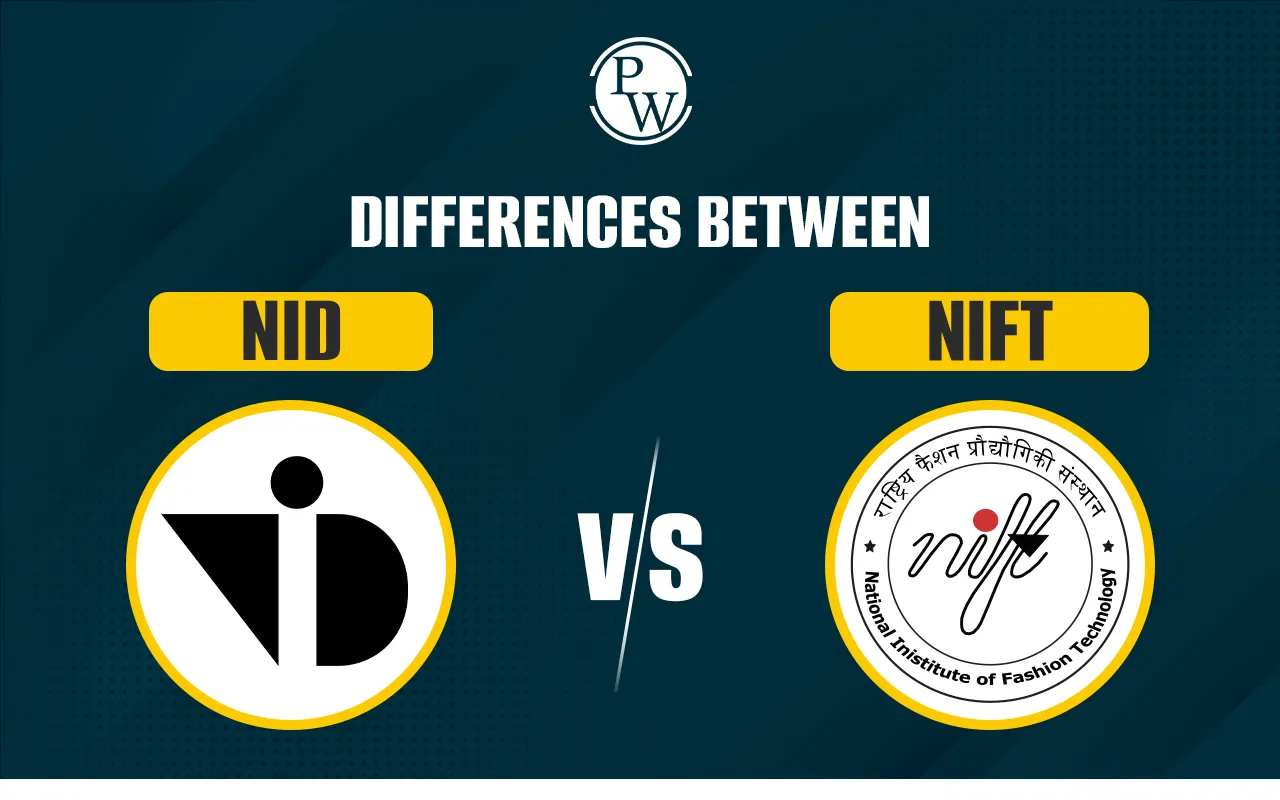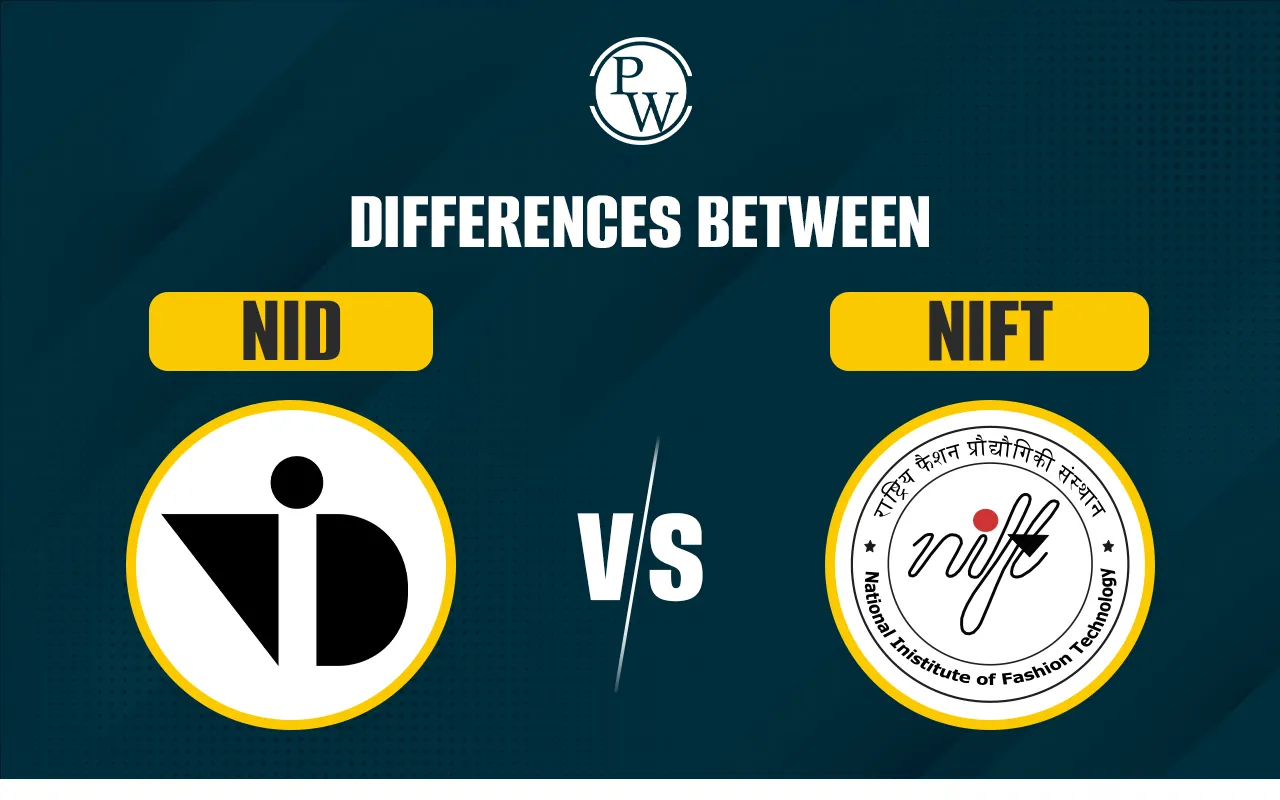

Difference Between NID and NIFT: Choosing between the National Institute of Design (NID) and the National Institute of Fashion Technology (NIFT) can be a difficult decision for students passionate about creativity and design. Both institutes are recognised across India for providing high-quality education in the field of design, innovation, and technology. However, the focus areas, admission process, and career opportunities offered by each institution are quite different.
Below, we will help you understand the major difference between NID and NIFT, including their courses, entrance exams, admission process, participating campuses, and placements.
NID Overview
National Institute of Design (NID) is an autonomous design institution under the Department for Promotion of Industry and Internal Trade (DPIIT), Ministry of Commerce and Industry, Government of India. It was established in 1961 and is considered one of the leading design institutes in India.
NID focuses on industrial design, communication design, textile design, and interdisciplinary design education. Its curriculum encourages research, innovation, and practical exposure, allowing students to learn by creating and experimenting with real-world design problems.
NID Campuses
NID currently has several campuses located across India, including:
- NID Ahmedabad (Main Campus)
- NID Gandhinagar
- NID Bengaluru
- NID Andhra Pradesh
- NID Haryana
- NID Madhya Pradesh
- NID Assam
Each campus offers undergraduate and postgraduate programs that cover different areas of design.
NIFT Overview
National Institute of Fashion Technology (NIFT) was set up in 1986 under the Ministry of Textiles, Government of India. It is known for promoting education in fashion design, fashion communication, technology, and management. NIFT provides students with strong exposure to fashion industry practices, textile science, garment construction, and business management. Its programs are designed to meet the growing demand for skilled professionals in the fashion and apparel sector.
NIFT has a wide presence with campuses in:
- NIFT Delhi
- NIFT Mumbai
- NIFT Bangalore
- NIFT Chennai
- NIFT Kolkata
- Hyderabad
- NIFT Gandhinagar
- Patna
- Bhopal
- Shillong
- Bhubaneswar
- Srinagar and several other cities.
Difference Between NID and NIFT
Both NID and NIFT are premier design institutes in India, but their academic focus and curriculum are quite distinct. Below, we’ve mentioned the difference between NID and NIFT:
| Difference Between NID and NIFT | ||
| Factors | NID | NIFT |
| Full Form | National Institute of Design | National Institute of Fashion Technology |
| Governing Body | Ministry of Commerce and Industry | Ministry of Textiles |
| Established In | 1961 | 1986 |
| Focus Area | Product, Industrial, Communication, and Textile Design | Fashion Design, Technology, and Management |
| Exam Conducting Body | NID DAT (Design Aptitude Test) | NIFT Entrance Exam |
| Course Level | UG and PG in Design | UG and PG in Fashion, Design & Management |
| Entrance Stages | DAT Prelims and DAT Mains | Written Test and Situation Test/Interview |
| Main Campus | Ahmedabad | New Delhi |
| Career Focus | Industrial and Product Design | Fashion and Textile Industry |
| Number of Campuses | 7 | 18+ |
| Official Website | www.nid.edu | www.nift.ac.in |
Courses Offered in NID and NIFT
Both NID and NIFT offer undergraduate and postgraduate design programs. However, the curriculum at each institute differs in approach and specialization. Below, we’ve mentioned the courses that are offered in NID and NIFT:
NID Courses
NID offers well-structured programs that promote hands-on learning and creative exploration. Its curriculum combines theory with practical studio work to help students build a strong foundation in design thinking.
- Bachelor of Design (B.Des): 4 years
- Master of Design (M.Des): 2.5 years
Specializations include:
- Industrial Design
- Communication Design
- Textile Design
- Apparel Design
- Animation Film Design
- Furniture Design
- Ceramic and Glass Design
NIFT Courses
NIFT’s courses are designed to meet the dynamic demands of the fashion and apparel industry. They integrate design, technology, and management to prepare students for various creative and professional roles.
- Bachelor of Design (B.Des): 4 years
- Bachelor of Fashion Technology (B.F.Tech): 4 years
- Master of Design (M.Des): 2 years
- Master of Fashion Technology (M.F.Tech): 2 years
- Master of Fashion Management (M.F.M): 2 years
Specializations include:
- Fashion Design
- Textile Design
- Accessory Design
- Fashion Communication
- Knitwear Design
- Fashion Technology
- Fashion Management
Admission Process in NID and NIFT
Below, we’ve mentioned the Admission Process that is followed in NID and NIFT:
NID Admission Process
The NID admission is based on a two-stage Design Aptitude Test (DAT), which includes:
- NID DAT Prelims: A written test evaluating design awareness, creativity, visualization, and problem-solving ability.
- NID DAT Mains: Studio test and personal interview assessing a candidate’s practical design skills.
Final selection is based on overall performance in both stages. Candidates must also fulfill eligibility criteria as prescribed for each program.
NIFT Admission Process
NIFT admission involves:
- Written Test: Comprising the General Ability Test (GAT) and the Creative Ability Test (CAT).
- Situation Test/Interview: Conducted for shortlisted candidates to assess innovation and material handling skills.
For postgraduate programs like MFM and MFTech, candidates may also need to appear for a Group Discussion and Personal Interview round.
NID and NIFT Exam Pattern
Both NID and NIFT conduct national-level entrance exams to assess a candidate’s creativity, visualization skills, and design aptitude. Below, we’ve mentioned the Exam Pattern of NID and NIFT in the difference between NID and NIFT:
| NID and NIFT Exam Pattern | ||
| Aspect | NID DAT | NIFT Entrance Exam |
| Type of Exam | Offline (Pen and Paper) | Offline/Online |
| Prelims | Objective and Subjective Questions | GAT (General Ability Test) and CAT (Creative Ability Test) |
| Mains | Studio Test and Personal Interview | Situation Test or Interview |
| Duration | 3 Hours | 2 to 3 Hours |
| Skills Tested | Creativity, Visualization, Observation, and Design Thinking | Fashion Awareness, Reasoning, Communication, and Innovation |
Career Opportunities and Placements
Both NID and NIFT provide excellent placement support and help students build strong professional portfolios.
Career After NID
Graduates from NID can work in:
- Industrial design companies
- Product manufacturing firms
- Advertising agencies
- UI/UX design studios
- Animation and media industries
- Government and private design consultancies
Students often pursue roles such as Product Designer, Graphic Designer, Animation Artist, Industrial Designer, and Design Consultant.
Career After NIFT
Graduates from NIFT are recruited in:
- Fashion houses
- Textile industries
- Apparel manufacturing companies
- Retail brands
- E-commerce platforms
- Fashion journalism and styling
Common roles include Fashion Designer, Textile Designer, Fashion Merchandiser, Fashion Illustrator, and Visual Merchandiser.
Which One Should You Choose?
Choosing between NID and NIFT depends on your area of interest.
- If you are inclined toward industrial design, product design, animation, or communication design, then NID is a better fit.
- If you have a strong interest in fashion, textiles, or apparel management, then NIFT is the ideal choice.
Both institutions have a rich legacy and produce creative professionals who contribute to India’s growing design and fashion sectors.
Both NID and NIFT hold strong reputations in the field of design and creativity. While NID focuses on industrial and product design, NIFT is deeply rooted in the fashion and textile domain. Understanding their key difference between NID and NIFT, the admission process, and courses will help students make an informed choice based on their career goals and interests.
